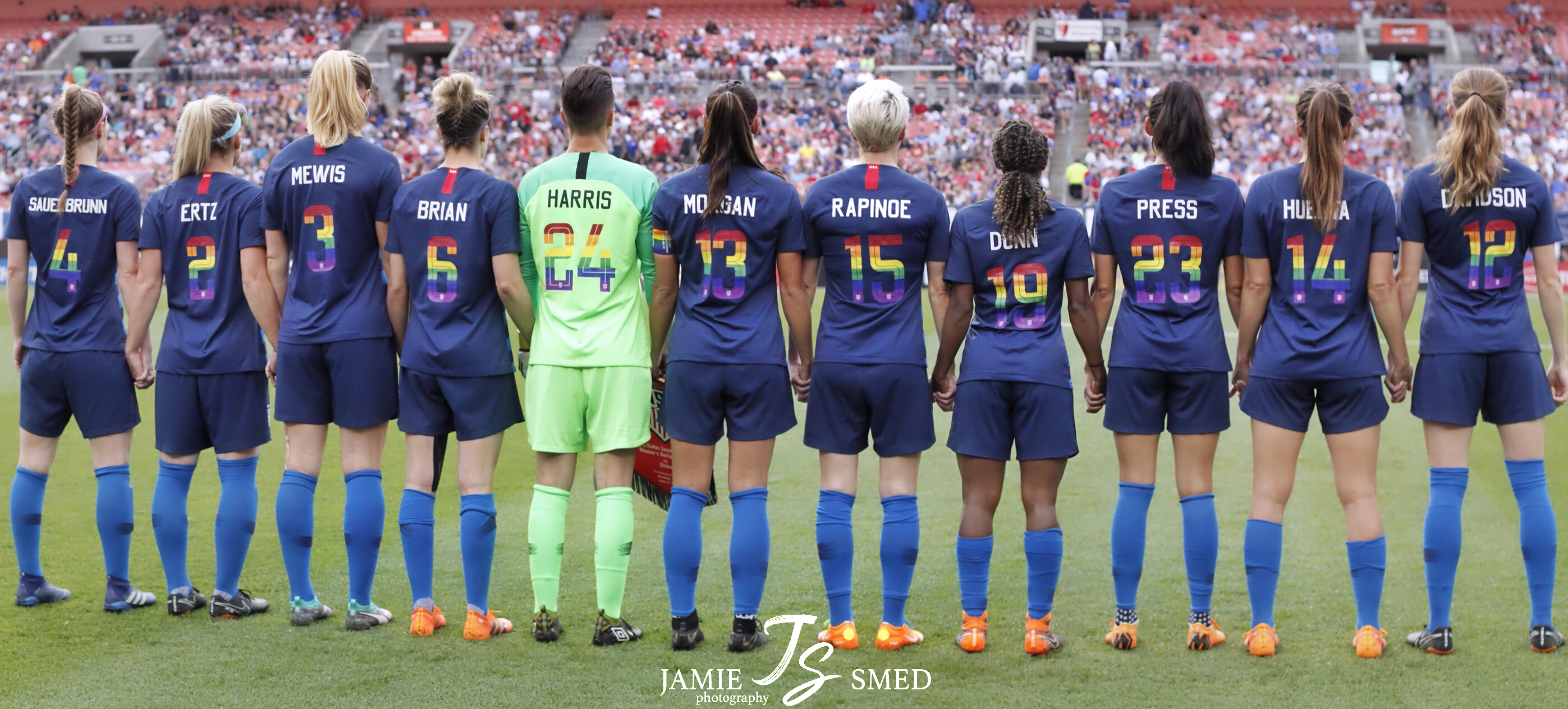Unless you’e been living under a rock, you’re aware that the US women’s national team won the 2015 Women’s World Cup. Their results: 3-1 vs. Australia, 0-0 vs. Sweden, 1-0 vs. Nigeria to win their group, 2-0 vs. Colombia, 1-0 vs. China, 2-0 vs. Germany, and finally 5-2 vs. Japan in Carli Lloyd’s signature performance. But with the exception of those first 15-20 minutes against Japan, this was a USWNT that mainly relied on its stellar backline and goalkeeper to win the tournament, and it worked, as they finished the tournament with five clean sheets from seven matches to kick off the Jill Ellis era with the one trophy Pia Sundhage couldn’t quite win.
Fast forward four years later, and the biggest criticism of the US is that their defense is far too leaky, with four sloppy goals conceded in a pair of 2-2 draws with Japan and England. In the first match following the SheBelieves Cup setback, the USWNT took on Australia and again struggled defensively, conceding three. But in the end, that didn’t matter because the US scored five. Three days later, they won 6-0 against Belgium in the final match before the pre-World Cup camp begins in May, and having watched the full 90 minutes against Belgium, I can honestly say that I have never seen a USWNT perform like that.
Obviously, Belgium is a step down from Australia and it would be foolish to think the clean sheet in this match is a reflection of how things will be as the US progresses through the World Cup. At times, especially in the latter stages, Belgium was afforded too much time and space on the ball in the attacking third. A deflected shot had Ashlyn Harris scrambling across her goal to make a save, and while the US caught a break in that it hit the post, that emphasizes an area on which Jill Ellis can have her team improve. But even with a less than perfect defense, this team will deservedly be a World Cup favorite simply because of what it has going forward.
The US started a less than full strength team with players shuffled around in the formation, and it worked flawlessly. I thought Crystal Dunn, who played left back against Australia and has been shuffled around Ellis’ lineup since she broke into the fold in 2016, was stellar in the midfield. Mallory Pugh and Christen Press got the start on the wings and terrorized Belgium’s full backs, creating countless crossing opportunities for the US. Carli Lloyd played the first half as a striker and ended up with two goals to her name, and when Alex Morgan came off the bench in the second half, she played on the left wing and ended up with a goal in seven minutes. More importantly, the US pressed Belgium high up the pitch and looked fairly adept at it, consistently winning the ball back in the attacking half and allowing the attack to stay at full throttle. I haven’t seen enough of the USWNT recently to know if this is going to be Jill Ellis’ preferred tactic, but if it is, then this will certainly be a much more stretched team than we’re accustomed to seeing. So when Morgan moves back into the middle and the regular starters such as Megan Rapinoe, Tobin Heath, and Rose Lavelle are back in the fold, the attack shouldn’t look all that different.
Even on days where the US isn’t as free flowing as it was against Belgium, the four set piece goals on the night show another facet of the Americans’ attacking prowess. There are better teams than Belgium waiting, and quality chances become scarce in those games. Contesting for set pieces and winning the ball over defenders can be the difference between victory and defeat in close games at the highest level, so that will be a boon for Ellis as well.
The biggest conundrum in this team for me is Julie Ertz. She’s no doubt a starter for this team, and against Australia, she was the third midfielder alongside Lavelle and Lindsey Horan. Against Belgium though, to accommodate Sam Mewis and move Dunn into the midfield, Ertz slotted in at center back, which is where she played in the 2015 World Cup run. I thought the US looked much better with her in the back than they did when she stepped into the midfield in both its defensive organization as well as in possession. As Ertz moved back though, Ellis will have to break up her preferred center back pairing of Becky Sauerbrunn and Abby Dahlkemper, and since Sauerbrunn retained her spot against Belgium, Dahlkemper seems to be the casualty. This plays into the larger issues the US has with its defense in general. Ali Krieger got the start at right back, but Kelley O’Hara, who is likely Ellis’ first choice, has been battling an ankle injury since October. Should O’Hara be healthy by June, she should slot in, but otherwise the spot is up for grabs. On the other side, after Sunday’s midfield performance from Dunn, Ellis may rethink playing her at left back, potentially opening up another spot in the backline. Maybe Dahlkemper gets shifted out wide, or maybe she gets dropped altogether. At this point, I couldn’t tell you.
With all of that being said, because many of the players in the USWNT pool are versatile, Ellis has been known to tinker with her lineups with success over her time in charge. By the time the Women’s World Cup is over, it’s completely possible that the US gets a fourth star on its jersey because of its ability to roll out different lineups that better neutralize the opponent’s strengths and keeps teams off balance. With how prolific the attack has been, seeing the USWNT looming in France is a daunting task.
Yet however dangerous the attack is, Ellis will want to find more stability in her back line. In six games against World Cup teams this year, the US conceded 10 goals. That probably won’t win the World Cup, but what Ellis can’t afford to do is set up a team that will defend well by stifling the attacking form that has blossomed in 2019.
With the roster that the USWNT will likely have in France, the attacking identity of this team won’t be Abby Wambach’s aerial prowess but the technical abilities of Morgan, Heath, and Rapinoe, among others. If Ellis has to sacrifice defensive solidity for it, then so be it. I’d rather see this US team go down playing with fire over failing to break down a team in a bunker.






We will break down all bunkers! Go USA!!!